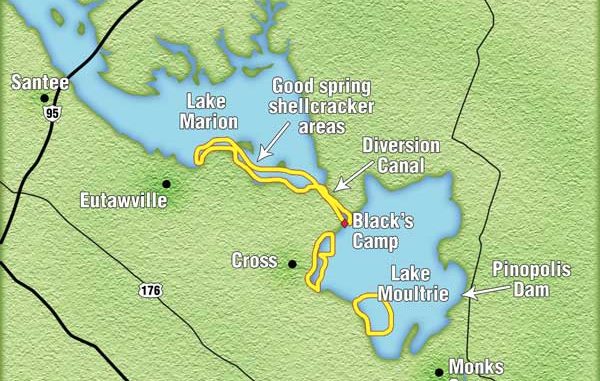
It’s time for big shellcrackers to move onto their beds to spawn, so why not visit the waters that produced the biggest ‘cracker on record?
“Polly want a cracker?”
I don’t know who Polly was, but it almost seems like she must have spent some time on the Santee Cooper lakes during the spring. After all, what could possibly do a finer job of keeping ’crackers on one’s mind all the time?
Santee Cooper, as Lake Marion and Lake Moultrie are most-often collectively dubbed, supports one of the nation’s truly elite populations of redear sunfish — shellcrackers, sometimes shortened to ’crackers. During the spring, they move shallow to spawn, get highly concentrated and become easier to find than at any other time of the year.
It’s fun, fast-action fishing, and it yields big messes of fish that are great for the frying pan.
Santee Cooper has all the ingredients for growing big shellcrackers. ’Crackers tend to thrive in large, fertile systems that have plenty of vegetation. The vegetation supports big populations of snails and other invertebrates, which are the very things that make shellcrackers fat and happy.
Scott Lamprecht, the fisheries biologist over the Santee Cooper lakes for the S.C. Department of Natural Resources, is amazed at how the fishery holds up year after year, despite tremendous pressure. “The plethora of super native plants that are in the system now will only serve to sustain the fishery through the years,” Lamprecht said. “It’s a very stable fishery and not one that we expect to crash.”
So just how big do shellcrackers grow in Santee Cooper?
As big as they grow anywhere in the world.
The world record for the species — a whopping 5-pound, 7½-ounce fish — came from the Diversion Canal, which links the two big lakes, in 1998. Fish that break the 2-pound mark aren’t uncommon at all when the bite is really hot.
“We aren’t seeing as many of the huge fish — the 4-pounders — as we were when the hydrilla was in the lake,” Lamprecht said, “but we still see plenty of the really nice 2- and 3-pounders.”
The SCDNR does not have a formal sampling index for shellcrackers, and no creel surveys are currently ongoing, so Lamprecht’s understanding of the fishery comes from anecdotal evidence. That said, he hears a lot of reports from fishermen, especially during the spring, and he sees a lot of shellcrackers in shallow water when he samples largemouth bass populations during the spring.
Shellcrackers can be caught year-round on the Santee Cooper lakes, but Kevin Davis of Cross, like many Santee Cooper regulars, does the bulk of his targeted shellcracker fishing between late March and the end of May, when the fish move shallow to spawn and pile up in predictable locations.
“In the spring, the shellcrackers will average about a pound, but 2-pounders are not uncommon,” Davis said. “Every now and then, someone will catch one up to three pounds.”
As a guide and co-owner of Black’s Camp on Lake Moultrie, Davis keeps a close watch on what the ’crackers are doing throughout the spring.
“The spring shellcracker fishing gets good when the water temperature reaches about 70 degrees,” Davis said. “The best fishing occurs around the spring new and full moons — possibly in late March but normally in April and May, with May typically being better.”
Unlike bluegills, which often bed repeatedly during a single year, shellcrackers only spawn once per year. They don’t all spawn at the same time, though, and it’s not uncommon for there to be at least some spawning activity coinciding with three different spring full moons, Lamprecht said.
When fishermen start catching shellcrackers shallow, the word spreads pretty quickly through Santee Cooper Country, and anglers around both lakes head for shallow, backwater areas along the lakes’ edges.
Davis looks for spawning shellcrackers in the back of coves in one to five feet of water — often around alligator grass. The shellcrackers bed quite shallow, and they generally will be under floating vegetation, tight to cut banks or among cypress knees. Lamprecht believes they seek cover for concealment from overhead predators such as ospreys.
Davis focuses much of his attention on the lake’s northwestern shore, roughly from Black’s Camp to the Duck Pond; however, he also points toward the Hatchery area and Russellville Flats as good areas to look for shellcrackers on Lake Moultrie. On Marion, he concentrates on the extensive backwaters that extend from the Rocks Pond area down the lake’s south bank to the mouth of the canal. The Diversion Canal remains a shellcracker hotspot though much of the year, and Davis’ favorite places to target spawning fish on both lakes are close to the canal at opposite ends.
Lamprecht said that the area near Stumphole Landing is a key shellcracker spawning flat. “You can always tell when they are on the beds, because cars will be parked half a mile up the road from the landing,” he said. “Word gets around pretty quickly!”
When shellcrackers are extremely shallow, it’s possible to see the beds or to spot the fish cruising or holding over their nests. More often, though, Davis finds the fish simply by fishing for them. Hitting the backs of coves, where shellcrackers tend to spawn, he methodically works along grassy edges, placing a bait in every hole in the vegetation or cut in the weedline.
“When you catch one, fish that area hard,” Davis said. “You are probably about to catch a bunch.”
Another good clue that you’re close to a nesting colony is catching an extremely dark- colored fish, Lamprecht said. “The male redears turn almost black during the spawn, so if you catch a really dark one, you’re probably close to beds. If they are all black, you’re catching all males.
The males move onto the beds slightly before the females, so if Davis catches a bunch of males from a specific spot, he will return to that spot in a day or two, expecting to find some big female shellcrackers.
Davis does all his shellcracker fishing with a 16-foot fiberglass Shakespeare pole (no reel), which is set up with 16 feet of line and rigged simply with a cigar-style float, split shot and hook baited with a worm. There is no need for long casts for this style of fishing, and the simple rig allows Davis to quickly and accurately place his offering in every little cut that might hold fish. When the cork darts under or moves decisively sideways, he hooks the fish with a lift of the rod and then swings it aboard or wears it down the bend of the long wispy rod, if it’s a big ’cracker.
The small, cigar-style floats are extremely sensitive, and they can be easily adjusted according to the bottom depth. Davis wants his worm to be as close as possible without actually laying on the bottom. He uses a No. 4 Aberdeen hook.
“That’s a small hook, but you don’t hang it in the wood nearly as much,” Davis said.
Davis fishes exclusively with worms when specifically targeting shellcrackers. He only hooks a worm a single time, running the hook through the collar, because he wants the worm to do plenty of wiggling.
Later in the season, when bluegills start bedding, he’ll use both worms and crickets, and eventually he’ll switch to mostly crickets. By that time he’s bluegill fishing, though, and that is another story for another time!


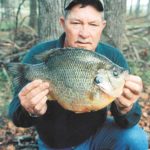
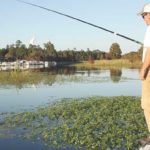

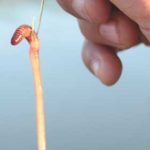
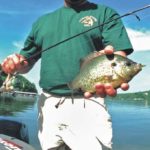
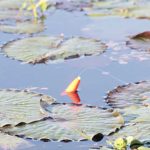


Be the first to comment